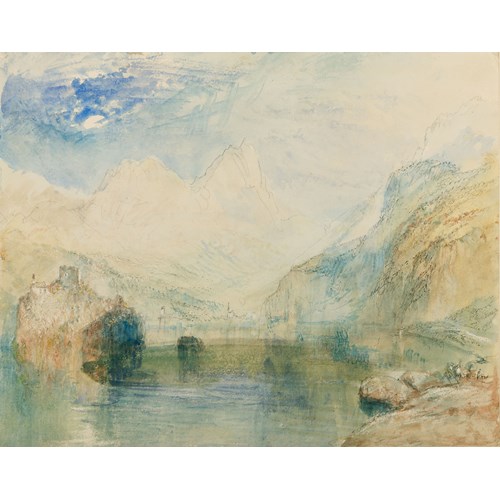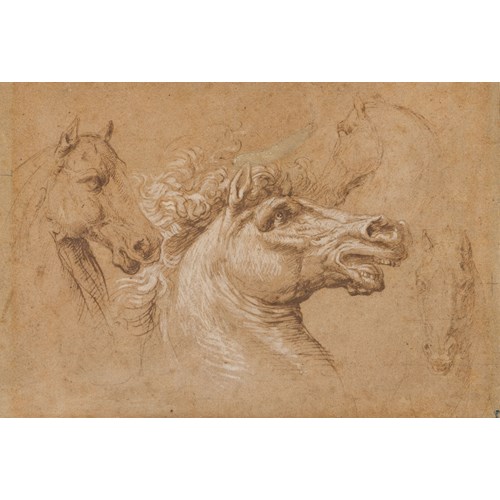François Boucher
Aurora and Cephalus
Epoque 1600-1750, 1750-1850
Medium Brown ink, Oval, Black chalk with stumping, White chalk on blue paper, Faded to buff
Dimension 27.9 x 37.5 cm (11 x 14³/₄ inches)
Laid down on an 18th century French mount, with the blind stamp of the mountmaker Jean-Baptiste Glomy (Lugt 1085, showing his full surname) applied twice, once below the bottom of the oval composition and again near the lower right corner of the mount.
Epoque: 1600-1750, 1750-1850
Medium: Brown ink, Oval, Black chalk with stumping, White chalk on blue paper, Faded to buff
Signature: Inscribed F. Boucher in brown ink near the lower right corner of the mount.
Dimension: 27.9 x 37.5 cm (11 x 14³/₄ inches)
Provenance: Abel-François Poisson de Vandières, Marquis de Marigny et de Menars, Paris
His posthumous sale, Paris, Place des Victoires, Hôtel de Menars, 18 March 1782 onwards, part of lot 289 (‘L’Aurore & Céphale, & la Colere de Neptune. Ces deux morceaux sont aux crayons noir & blanc, sur papier bleu.’, both sold framed for 91,2 livres)
Veil-Picard collection, Paris
Anonymous sale, Paris, Artcurial, 19 June 2007, part of lot 21 (sold for €73,113)
Wildenstein, New York.
Literature: L. Soullié and Ch. Masson, ‘Catalogue raisonné de l’oeuvre peint et dessiné de François Boucher’, in André Michel, François Boucher, Paris, 1906, p.27, no.454; Alexandre Ananoff, L’oeuvre dessiné de François Boucher (1703-1770), Paris, 1966, Vol.I, p.239, under no.920; Alexandre Ananoff and Daniel Wildenstein, François Boucher, Lausanne and Paris, 1976, Vol.II, p.295, no.670/1, fig.1750 (as Venus and Endymion); Edith Appleton Standen, European Post-Medieval Tapestries and Related Hangings in The Metropolitan Museum of Art, New York, 1985, Vol.I, p.394, under no.57.
Exhibition: The story of Aurora and Cephalus occurs in Book VII of Ovid’s Metamorphoses. The young and beautiful hunter Cephalus had recently been married to Procris, daughter of the King of Athens, but was abducted by Aurora, goddess of the dawn, who had fallen in love with him. The goddess soon tired of him, however, since he could only speak of his beloved Procris, and eventually released him, but not before planting a seed of doubt in his mind about the faithfulness of Procris which would eventually lead to her accidental death.
As has been recently noted, ‘Mythological subjects were Boucher’s forte from very early in his career, and over the course of four decades he produced a host of richly pictorial works that center on the stories, loves, foibles, and attributes of the Olympian gods.’ Boucher must have found the subject of Aurora and Cephalus quite appealing, since he treated the theme several times during his long career, notably in one of his finest early paintings, a large canvas of 1733 today in the Musée des Beaux-Arts in Nancy. The same subject is also found in a painting of 1736-1739, commissioned by the Prince de Rohan as an overdoor for a bedroom in the Hôtel de Soubise and today in the Archives Nationales in Paris, and in a late vertical painting of Aurora and Cephalus, signed and dated 1769, in the J. Paul Getty Museum in Los Angeles. Other paintings of Aurora and Cephalus by Boucher include a large canvas of c.1745 in a New York private collection and an upright oval painting, signed and dated 1764, in the Louvre, which was the model for one of the Tentures de Boucher tapestries.
Unlike the previous drawing of Neptune and Amymone, the present sheet cannot be definitively related to Boucher’s paintings of 1763-1764 for the Tentures de Boucher tapestries. While the subject of Aurora and Cephalus does appear in the Tentures de Boucher tapestries, it is as an oval composition of upright, vertical format. Alastair Laing has suggested that ‘at some point, [Jacques] Neilson – or a client – must have wanted a transverse oval version of the Aurora & Cephalus’, but no such horizontal composition seems to have ever been woven, at the Gobelins or elsewhere.
The present pair of oval drawings by Boucher once belonged to one of the most significant figures in the Parisian art world in the 18th century. Abel-François Poisson, Marquis de Marigny (1727-1781), was the brother and heir of the Marquise de Pompadour, King Louis XV’s official mistress between 1745 and her death in 1764. Marigny served as directeur general des bâtiments, jardins, arts, académies, et manufactures de roi between 1751 and 1773, and amassed a significant collection of paintings and works of art that, as one modern scholar has written, ‘was broad in scope, progressive in taste, exceptional in quality, and extraordinary in provenance.’
Both this and the previous drawing have been dated by Alastair Laing to the 1760s. However, as he has noted, ‘It seems most likely that that of Neptune & Amymone was done in 1764, but that that of Aurora and Cephalus was done at a slightly different time – whenever it was that a transverse oval version of the upright oval version of it was painted by Boucher or contemplated…there are differences between the two in the colour both of the papers and of the chalks used on them. This would further suggest that they were genuinely designs for the paintings that served as models for the tapestries, and that they were submitted at different times…to the marquis de Marigny for his approval, who then held onto them. This is particularly likely to have been so, since – unlike in the case of some other designs for tapestries by Boucher - there is no evidence of there ever having been any oil sketches for them or for any of the other compositions used in the Tentures de Boucher...Were they to have been drawn from the paintings, just as gifts for Marigny, in gratitude for the commission, one would have expected the two to have been treated in exactly the same way.’
Both this and the pendant of Neptune Rescuing Amymone on their original 18th century mounts, each twice stamped by the eminent Parisian dealer, expertand mountmaker Jean-Baptiste Glomy (c.1720-1786). From the middle of the 1740s onwards, Glomy established a successful business as a mounter and framer of drawings and prints. He counted among his clients both artists and collectors, the latter including Madame de Pompadour and her brother, the Marquis de Marigny, as well as such prominent figures as Pierre-Jacques-Onésyme Bergeret de Grancourt, the Chevalier de Damery, Laurent Grimod de la Reyniére, Gilbert Paignon-Dijonval, Pierre Paul Louis Randon de Boisset, the Abbé de Saint-Non and the Duc de Tallard. Among artists, Glomy’s best client was arguably François Boucher, many of whose finest drawings he was given to mount. According to Glomy’s account book, Boucher was charged a special rate of one and a half livres per drawing, which was half the price paid by private collectors.
An autograph variant of this composition, of similar size but drawn in black chalk alone and somewhat simpler and less finished, was formerly in a private collection in Florence, and was recently offered for sale at auction in London. Alastair Laing has suggested that the drawing may have been a preparatory sketch for the present sheet. He further notes that it is on a Glomy mount identical to those on the present pair of drawings, and has plausibly suggested that all three drawings (as well as, presumably, a now-lost sketch for the related oval composition of Neptune and Amymone), may have been given by Boucher to Glomy to mount, with the more highly finished pair of drawings on blue paper, here exhibited, then presented to Marigny, the surintendent des bâtiments.
Plus d'œuvres d'art de la Galerie









 in a Glass ‘Liebe Tante, ich bin im Moment etwas nervös…’_T638203653974598426.jpg?width=500&height=500&mode=pad&scale=both&qlt=90&format=jpg)